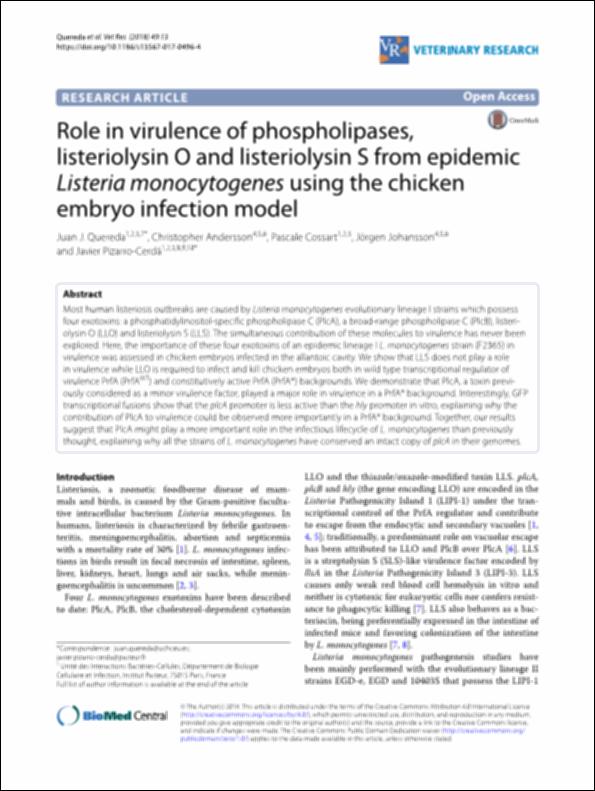Por favor, use este identificador para citar o enlazar este ítem:
http://hdl.handle.net/10637/12999Role in virulence of phospholipases, listeriolysin O and listeriolysin S from epidemic "Listeria monocytogenes" using the chicken embryo infection model
| Título : | Role in virulence of phospholipases, listeriolysin O and listeriolysin S from epidemic "Listeria monocytogenes" using the chicken embryo infection model |
| Autor : | Quereda Torres, Juan José Andersson, Christopher Cossart, Pascale Johansson, Jörgen Pizarro Cerdá, Javier |
| Materias: | Chickens - Embryology.; Intoxicación por alimentos.; Food poisoning.; Pathogenic bacteria.; Listeriosis.; Bacterias patógenas.; Pollos - Embriología. |
| Editorial : | BioMed Central. |
| Citación : | Quereda, J.J., Andersson, C., Cossart, P., Johansson, J. & Pizarro‑Cerdá, J. (2018). Role in virulence of phospholipases, listeriolysin O and listeriolysin S from epidemic "Listeria monocytogenes" using the chicken embryo infection model. Veterinary Research, vol. 49, art. 13 (06 feb.). DOI: https://doi.org/10.1186/s13567-017-0496-4 |
| Resumen : | Most human listeriosis outbreaks are caused by Listeria monocytogenes evolutionary lineage I strains which possess four exotoxins: a phosphatidylinositol-specific phospholipase C (PlcA), a broad-range phospholipase C (PlcB), listeriolysin O (LLO) and listeriolysin S (LLS). The simultaneous contribution of these molecules to virulence has never been explored. Here, the importance of these four exotoxins of an epidemic lineage I L. monocytogenes strain (F2365) in virulence was assessed in chicken embryos infected in the allantoic cavity. We show that LLS does not play a role in virulence while LLO is required to infect and kill chicken embryos both in wild type transcriptional regulator of virulence PrfA ( PrfAWT) and constitutively active PrfA (PrfA*) backgrounds. We demonstrate that PlcA, a toxin previously considered as a minor virulence factor, played a major role in virulence in a PrfA* background. Interestingly, GFP transcriptional fusions show that the plcA promoter is less active than the hly promoter in vitro, explaining why the contribution of PlcA to virulence could be observed more importantly in a PrfA* background. Together, our results suggest that PlcA might play a more important role in the infectious lifecycle of L. monocytogenes than previously thought, explaining why all the strains of L. monocytogenes have conserved an intact copy of plcA in their genomes. |
| Descripción : | Este artículo se encuentra disponible en la siguiente URL: https://veterinaryresearch.biomedcentral.com/articles/10.1186/s13567-017-0496-4 |
| URI : | http://hdl.handle.net/10637/12999 |
| Derechos: | http://creativecommons.org/licenses/by/4.0/deed.es |
| ISSN : | 1297-9716 (Electrónico). |
| Fecha de publicación : | 6-feb-2018 |
| Centro : | Universidad Cardenal Herrera-CEU |
| Aparece en las colecciones: | Dpto. Producción y Sanidad Animal, Salud Pública Veterinaria y Ciencia y Tecnología de los Alimentos |
Los ítems de DSpace están protegidos por copyright, con todos los derechos reservados, a menos que se indique lo contrario.


